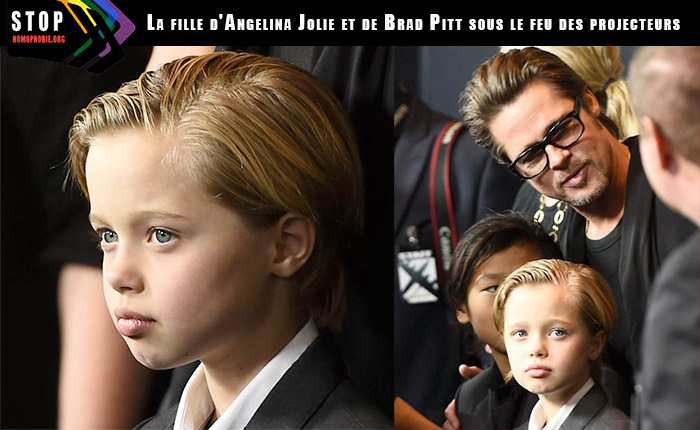>> Brad Pitt and Angelina Jolie’s daughter Shiloh dresses as a boy and wants to be known as John. But do signs like these mean a child is a tomboy, or could it be the start of gender identity issues?
Le 16 décembre dernier, Madame Pitt qui avait a la varicelle n’a pas pu se rendre à l’avant-première de son troisième long-métrage, «Invincible» à Los Angeles, mais elle a envoyé son mari et ses deux fils aînés pour la représenter, ainsi que Shiloh, en costume, cravate et cheveux courts 🙂
En effet, depuis l’âge de 3 ans, Shiloh Jolie-Pitt, premier enfant biologique du couple formé par Brad Pitt et Angelina Jolie aime s’habiller au masculin. Ses parents, ont donc décidé de la suivre dans ses choix, comme l’expliquait l’actrice et réalisatrice à l’époque : « Nous avons dû lui couper les cheveux. Elle pense qu’elle est comme ses frères. Elle adore les costumes. Elle est fascinante dans ses choix. Je ne serai jamais un parent qui la forcera à être ce qu’elle n’est pas. Je pense que ce serait une très mauvaise éducation. On devrait permettre aux enfants de s’exprimer de n’importe quelle façon, sans que quelqu’un les juge parce que c’est une partie importante de leur croissance.»
Malheureusement, la grand-mère paternel de Shiloh/John n’est pas du même avis. En effet, Jane la maman de Brad Pitt est assez conservatrice et le look et l’attitude de sa petite-fille lui déplaisent.
Pourtant, ça lui va à merveille. Effet de style… Shiloh a la mode dans le sang. Et… John, ça lui va très bien aussi 🙂
Sur le nouvelObs, Michaël Larrar, Psychiatre qui travaille auprès d’enfants s’explique : « Si leur fille veut s’habiller en garçon, ou l’inverse… c’est en général un processus tout à fait inconscient et classique. Il est assez fréquent que des jeunes enfants jouent avec leur identité, avec une adhésion plus ou moins forte. »
La plupart des enfants veulent tous, un jour, se prendre pour quelqu’un d’autre – un joueur de foot, un personnage Disney… – car cette personne présente à leurs yeux plus d’avantages qu’eux. Elle est plus puissante et va les rassurer.
Il ne faut pas s’en inquiéter si l’adhésion de l’enfant à cet autre personnage, ou sexe, n’est pas trop forte, et qu’il revient à son identité. La plupart du temps, les choses se défont d’elles-mêmes, naturellement.
Souvent, la première question des parents porte sur l’orientation sexuelle de leur enfant, mais celle-ci se définit rarement de façon nette à ces âges-là.
Dans le cas d’une fille qui s’habille en garçon, on est plus dans le registre d’un manque de confiance en son identité que dans celui de l’orientation sexuelle.
Une identification aux parents ou frères et sœurs
Le plus fréquemment, cette identification se fait par rapport à un membre de la famille :
– à un des parents, qui manque à l’enfant : en lui ressemblant, l’enfant l’emmène un peu avec lui ;
– parfois, s’il l’un des parents est déprimé, cela peut entraîner une « contre-identification » : l’enfant s’identifie au parent qui va bien ;
– dans de rares cas, si l’un des parents ne va pas bien, l’enfant peut s’identifier à ce dernier dans la volonté de le « réparer », de « compléter » le parent en souffrance ;
– et le plus fréquemment, on s’identifie aussi par jalousie de ses frères et sœurs : concernant la fille de Brad Pitt et Angelina Joli, même s’il m’est impossible d’analyser son comportement sans la connaître, on peut supposer qu’il est possible qu’elle veuille être un garçon par identification à ses frères. Elle voudrait ainsi leur ressembler par jalousie, pour attirer l’attention, comme eux le font.
Les parents ne doivent pas s’y opposer, mais…
Si l’adhésion d’un enfant au sexe opposé est forte, je recommande aux parents de faire preuve d’un peu de détachement. Ils ne doivent être ni dans le rejet excessif de la demande de leur enfant, ni dans une adhésion totale, comme cela semble être le cas avec Shiloh.
Les parents ne doivent pas se bagarrer avec leur fille pour l’obliger à mettre des robes, mais ne doivent pas non plus suivre en permanence les volontés de leur enfant. Une fille qui s’habille en garçon peut passer inaperçu, mais un garçon qui s’habille en fille peut subir des discriminations. Il faut donc y être attentif, car cela peut générer un rejet social.
Ne pas être dans l’abandon psychique de son enfant
Le rôle des parents n’est pas d’être dans une adhésion qui se voudrait bienveillante, mais qui est en fait infantile et qui n’apporterait pas de solutions au mal-être de l’enfant. Si on va dans son sens, l’enfant n’obtiendra pas de réponses à ses difficultés d’identification.
Sans tenir un discours alarmiste, les parents doivent signifier à leur enfant qu’ils sont inquiets et qu’ils s’interrogent. Et si cela persiste, il faudra en parler à un médecin à un moment donné, afin de rechercher les causes de son trouble de l’identité.
Il est normal qu’un enfant passe par ces questionnement, ils le font tous, et chacun réagit différemment. Cela ne signifie pas qu’il deviendra transgenre ou transsexuel, l’éventualité de tels cas est exceptionnelle.
Mais quoi qu’il arrive, les parents ne doivent pas être dans l’abandon psychique de leur enfant. On n’est pas maître de son destin à 7 ou 8 ans.
avec l’AFP et le NouvelObs
>> Chez nos amis américains, la question s’est également posée dans les médias : Angelina Jolie’s eight-year-old daughter no longer wants to be known as Shiloh – she’d rather be called John. Her dad, Brad Pitt, recently disclosed in an interview that when he would call her ‘Shi’, she’d interrupt him saying, ‘I’m John’.
Now the whole family address her as John (so we will too), and at her mum’s recent Unbroken film premiere, she wore a suit and tie to match her older brothers Pax and Maddox. Her tomboy tendencies have clearly been going on for a while.
Back in 2010, Jolie told Vanity Fair: “She wants to be a boy. So we had to cut her hair. She likes to wear boys’ everything. She thinks she’s one of the brothers.”
It’s tempting to smile indulgently and turn a blind eye. But for many parents, this is a bit of a minefield.
Of course, lots of girls like the same toys, clothes and games as boys. But what about when a child seems to ‘want to be’ a member of the opposite sex? Does this hint at gender dysphoria, or identity issues? Or is it just a natural part of growing up?
Linda Blair, a clinical psychologist and author of The Happy Child, says it’s important not to overreact: “It could be so many other things that I wouldn’t jump to that conclusion,” she says.
For a child like John, her desire to be a boy could simply stem from having three brothers (although she does have two sisters, as well).
“Usually with a child, especially children with older siblings of the opposite gender, it’s normal to want to copy them and be like them,” explains Blair. “That’s quite a normal phase for a lot of kids.”
As a middle child (she’s eight, and has two younger siblings, three older ones) it could also be a desire for attention.
“A lot of times kids in the middle of a large family are looking desperately and legitimately for ways to get attention. So they’ll do whatever it takes to get it.”
More importantly, parents should remember that experimentation is a normal part of any child’s development. Most three to six year olds are obsessed with the idea of ‘male’ and ‘female’ – and the concept of ‘mummy and daddy’ – and this fascination can endure for some children.
It’s natural for kids to explore genders
“To explore what it means to be both genders is also totally normal,” says Blair. “But the problem is we have suppressed it for so many generations, that people are still uncomfortable with it. You can’t become what you are until you know what you’re not.”
She says it’s even worse for young boys who want to wear dresses and show their emotions, as their parents can struggle to accept it. She explains that research shows mums tend to still act warmly towards a ‘boyish’ girl, but often cool off towards a ‘girlish’ boy.
Mermaids, a charity that provides support to families whose children have gender identity issues, says the majority of its calls from parents concern boys.
« This is probably not because gender-variant behaviour is more common in boys but because a little girl who’s a tomboy tends to be less of a concern than a little boy who plays with Barbies,” the charity told the NHS.
But this attitude can be incredibly damaging for the child and is something that Blair thinks that parents need to work at accepting.
Parents need to just wait and see
“My reaction to a parent who’s saying ‘my girl’s in jeans and doesn’t act like a girl’, or ‘my boy’s in dresses’, is to say: watch, accept and see.
« Then, if it’s an attention issue, it’ll go away. If it’s exploration then they’ll have permission to do that. If it’s real, you’re giving them the time they need to make up their minds.”
Because, of course, these could also be signs that a child does have a serious gender identity issue, and could grow-up to be transsexual or transgender. Blair explains that if the signs have been going on for years, parents should approach a GP who can direct them to a gender identity clinic. This is especially important as their child reaches puberty and can more easily express themselves.
Don’t rush the process
Before puberty, Blair says there’s no real need for a parent to take their child to see anyone.
“I think welcome it and see where it goes. There’s nothing that needs to be done. There’s nothing to be frightened of because it’s a really gradual process. [Even if the child needed hormone blockers] it would probably take two years of discussions.
“The worst thing is to rush it. This is such a major fundamental decision.”
It’s why she says that parents who are worried about their child’s gender behaviour should try their hardest to accept it, without involving doctors.
But on the NHS website, Ady Davis, a psychosexual therapist with the North-East Gender Dysphoria Service suggests that if a young person or child is showing signs of depression or distress, then parents should approach a doctor.
Accept your child for who they are
“If your child is very strongly identifying with the opposite gender to the point where it’s causing the child or the family distress, seek help, » he says. “Signs of distress in a young person or child can include self-harm, destructive behaviour and depression.”
However, the most important thing for parents to remember is that there are no real ‘warning signs’ their child will become transgender or transsexual.
It might be a natural part of exploration, a reaction to siblings and the family set-up. And even if their child does continue to have those feelings, they may not opt for surgery. They may end up cross-dressing, or simply taking hormone blockers. It’s why Blair stresses that all parents can really do at such an early stage is accept their child for who they are:
“Whoever your child is, they’re not someone who’s ever been here before or will be here again. That’s more to celebrate than worry about. We think we know so much about genes and what we pass on. But this is an amazing person you don’t know – and you’re going to get to know them. »
From the outside, it seems the Jolie-Pitt clan are happy to let John’s fascination with dressing as a boy take it’s natural course.
As Blair adds: « That’s the most important thing ».


















